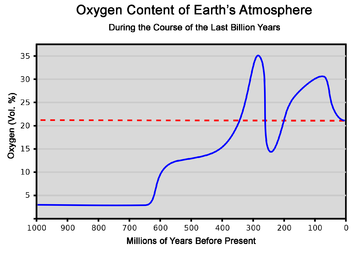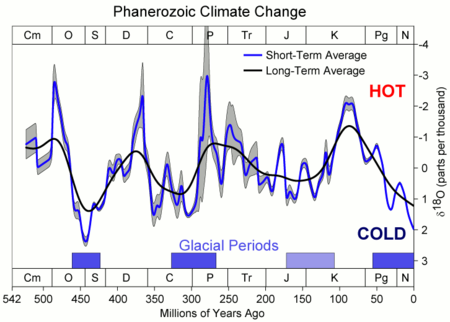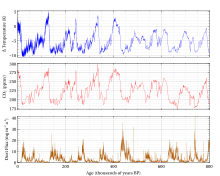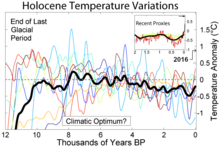Paleoclimatology
| Part of a series on |
| Paleontology |
|---|
 |
|
Paleontology Portal Category |
Paleoclimatology (
Paleoclimatology uses a variety of
The scientific field of paleoclimatology came to maturity in the 20th century. Notable periods studied by paleoclimatologists include the frequent glaciations that Earth has undergone, rapid cooling events like the Younger Dryas, and the rapid warming during the Paleocene–Eocene Thermal Maximum. Studies of past changes in the environment and biodiversity often reflect on the current situation, specifically the impact of climate on mass extinctions and biotic recovery and current global warming.[2][3]
History
Notions of a changing climate most likely evolved in
The scientific study of paleoclimatology began to take shape in the early 19th century, when discoveries about glaciations and natural changes in Earth's past climate helped to understand the
Reconstructing ancient climates


Paleoclimatologists employ a wide variety of techniques to deduce ancient climates. The techniques used depend on which variable has to be reconstructed (this could be temperature, precipitation, or something else) and how long ago the climate of interest occurred. For instance, the deep marine record, the source of most isotopic data, exists only on oceanic plates, which are eventually subducted; the oldest remaining material is 200 million years old. Older sediments are also more prone to corruption by diagenesis. Resolution and confidence in the data decrease over time.
Proxies for climate
Ice
Mountain
- Air trapped within fallen snow becomes encased in tiny bubbles as the snow is compressed into ice in the glacier under the weight of later years' snow. The trapped air has proven a tremendously valuable source for direct measurement of the composition of air from the time the ice was formed.
- Layering can be observed because of seasonal pauses in ice accumulation and can be used to establish chronology, associating specific depths of the core with ranges of time.
- Changes in the layering thickness can be used to determine changes in precipitation or temperature.
- Oxygen-18 quantity changes (δ18O) in ice layers represent changes in average ocean surface temperature. Water molecules containing the heavier O-18 evaporate at a higher temperature than water molecules containing the normal Oxygen-16 isotope. The ratio of O-18 to O-16 will be higher as temperature increases but it also depends on factors such as water salinity and the volume of water locked up in ice sheets. Various cycles in isotope ratios have been detected.
- Pollen has been observed in the ice cores and can be used to understand which plants were present as the layer formed. Pollen is produced in abundance and its distribution is typically well understood. A pollen count for a specific layer can be produced by observing the total amount of pollen categorized by type (shape) in a controlled sample of that layer. Changes in plant frequency over time can be plotted through statistical analysis of pollen counts in the core. Knowing which plants were present leads to an understanding of precipitation and temperature, and types of fauna present. Palynology includes the study of pollen for these purposes.
- Volcanic ash is contained in some layers, and can be used to establish the time of the layer's formation. Volcanic events distribute ash with a unique set of properties (shape and color of particles, chemical signature). Establishing the ash's source will give a time period to associate with the layer of ice.
A multinational consortium, the European Project for Ice Coring in Antarctica (EPICA), has drilled an ice core in Dome C on the East Antarctic ice sheet and retrieved ice from roughly 800,000 years ago.[6] The international ice core community has, under the auspices of International Partnerships in Ice Core Sciences (IPICS), defined a priority project to obtain the oldest possible ice core record from Antarctica, an ice core record reaching back to or towards 1.5 million years ago.[7]
Dendroclimatology
Climatic information can be obtained through an understanding of changes in tree growth. Generally, trees respond to changes in climatic variables by speeding up or slowing down growth, which in turn is generally reflected by a greater or lesser thickness in growth rings. Different species however, respond to changes in climatic variables in different ways. A tree-ring record is established by compiling information from many living trees in a specific area.
Older intact wood that has escaped decay can extend the time covered by the record by matching the ring depth changes to contemporary specimens. By using that method, some areas have tree-ring records dating back a few thousand years. Older wood not connected to a contemporary record can be dated generally with radiocarbon techniques. A tree-ring record can be used to produce information regarding precipitation, temperature, hydrology, and fire corresponding to a particular area.
Sedimentary content
On a longer time scale, geologists must refer to the sedimentary record for data.
- Sediments, sometimes lithified to form rock, may contain remnants of preserved vegetation, animals, plankton, or pollen, which may be characteristic of certain climatic zones.
- Biomarker molecules such as the alkenonesmay yield information about their temperature of formation.
- Chemical signatures, particularly Mg/Ca ratio of calcite in Foraminiferatests, can be used to reconstruct past temperature.
- Isotopic ratios can provide further information. Specifically, the δ18O record responds to changes in temperature and ice volume, and the δ13C record reflects a range of factors, which are often difficult to disentangle.

- Sedimentary facies
On a longer time scale, the rock record may show signs of sea level rise and fall, and features such as "fossilised" sand dunes can be identified. Scientists can get a grasp of long-term climate by studying sedimentary rock going back billions of years. The division of Earth history into separate periods is largely based on visible changes in sedimentary rock layers that demarcate major changes in conditions. Often, they include major shifts in climate.
Sclerochronology
- Corals (see also sclerochronology)
Coral "rings" are similar to tree rings except that they respond to different things, such as the water temperature, freshwater influx, pH changes, and wave action. From there, certain equipment can be used to derive the sea surface temperature and water salinity from the past few centuries. The δ18O of coralline red algae provides a useful proxy of the combined sea surface temperature and sea surface salinity at high latitudes and the tropics, where many traditional techniques are limited.[8][9]
Landscapes and landforms
Within climatic geomorphology, one approach is to study relict landforms to infer ancient climates.[10] Being often concerned about past climates climatic geomorphology is considered sometimes to be a theme of historical geology.[11] Climatic geomorphology is of limited use to study recent (Quaternary, Holocene) large climate changes since there are seldom discernible in the geomorphological record.[12]
Timing of proxies
The field of geochronology has scientists working on determining how old certain proxies are. For recent proxy archives of tree rings and corals the individual year rings can be counted, and an exact year can be determined. Radiometric dating uses the properties of radioactive elements in proxies. In older material, more of the radioactive material will have decayed and the proportion of different elements will be different from newer proxies. One example of radiometric dating is radiocarbon dating. In the air, cosmic rays constantly convert nitrogen into a specific radioactive carbon isotope, 14C. When plants then use this carbon to grow, this isotope is not replenished anymore and starts decaying. The proportion of 'normal' carbon and Carbon-14 gives information of how long the plant material has not been in contact with the atmosphere.[13]
Notable climate events in Earth history
Knowledge of precise climatic events decreases as the record goes back in time, but some notable climate events are known:
- Faint young Sun paradox (start)
- Great Oxygenation Event)
- Later Neoproterozoic Cambrian Explosion)
- Andean-Saharan glaciation (~450 Mya)
- Carboniferous Rainforest Collapse(~300 Mya)
- Permian–Triassic extinction event (251.9 Mya)
- Oceanic anoxic events (~120 Mya, 93 Mya, and others)
- Cretaceous–Paleogene extinction event (66 Mya)
- Paleocene–Eocene Thermal Maximum (Paleocene–Eocene, 55Mya)
- Last Glacial Maximum (~23,000 BCE)
- Younger Dryas/Big Freeze (~11,000 BCE)
- Holocene climatic optimum (~7000–3000 BCE)
- Extreme weather events of 535–536(535–536 CE)
- Medieval Warm Period (900–1300)
- Little Ice Age (1300–1800)
- Year Without a Summer (1816)
History of the atmosphere
million years ago) |
Earliest atmosphere
The
Second atmosphere
The next atmosphere, consisting largely of
Water-related sediments have been found dating from as early as 3.8 billion years ago.[15] About 3.4 billion years ago, nitrogen was the major part of the then stable "second atmosphere". An influence of life has to be taken into account rather soon in the history of the atmosphere because hints of early life forms have been dated to as early as 3.5 billion years ago.[16] The fact that it is not perfectly in line with the 30% lower solar radiance (compared to today) of the early Sun has been described as the "faint young Sun paradox".
The geological record, however, shows a continually relatively warm surface during the complete early
Third atmosphere
The constant rearrangement of continents by
The amount of oxygen in the atmosphere has fluctuated over the last 600 million years, reaching a peak of 35%
Climate during geological ages

- The Huronian glaciation, is the first known glaciation in Earth's history, and lasted from 2400 to 2100 million years ago.
- The Cryogenian glaciationlasted from 720 to 635 million years ago.
- The Andean-Saharan glaciation lasted from 450 to 420 million years ago.
- The Karoo glaciationlasted from 360 to 260 million years ago.
- The Quaternary glaciation is the current glaciation period and began 2.58 million years ago.
In 2020 scientists published a continuous, high-fidelity record of variations in Earth's climate during the past 66 million years and identified four climate states, separated by transitions that include changing greenhouse gas levels and polar ice sheets volumes. They integrated data of various sources. The warmest climate state since the time of the dinosaur extinction, "Hothouse", endured from 56 Mya to 47 Mya and was ~14 °C warmer than average modern temperatures.[20][21]
Precambrian climate
The Precambrian took place between the time when Earth first formed 4.6 billion years (
Phanerozoic climate

Major drivers for the preindustrial ages have been variations of the Sun, volcanic ashes and exhalations, relative movements of the Earth towards the Sun, and tectonically induced effects as for major sea currents, watersheds, and ocean oscillations. In the early Phanerozoic, increased atmospheric carbon dioxide concentrations have been linked to driving or amplifying increased global temperatures.[27] Royer et al. 2004[28] found a climate sensitivity for the rest of the Phanerozoic which was calculated to be similar to today's modern range of values.
The difference in global mean temperatures between a fully glacial Earth and an ice free Earth is estimated at 10 °C, though far larger changes would be observed at high latitudes and smaller ones at low latitudes.[citation needed] One requirement for the development of large scale ice sheets seems to be the arrangement of continental land masses at or near the poles. The constant rearrangement of continents by plate tectonics can also shape long-term climate evolution. However, the presence or absence of land masses at the poles is not sufficient to guarantee glaciations or exclude polar ice caps. Evidence exists of past warm periods in Earth's climate when polar land masses similar to Antarctica were home to deciduous forests rather than ice sheets.
The relatively warm local minimum between
Superimposed on the long-term evolution between hot and cold climates have been many short-term fluctuations in climate similar to, and sometimes more severe than, the varying glacial and interglacial states of the present
A similar, single event of induced severe climate change after a
Quaternary climate


The Quaternary
Note in the graphic on the right the strong 120,000-year periodicity of the cycles, and the striking asymmetry of the curves. This asymmetry is believed to result from complex interactions of feedback mechanisms. It has been observed that ice ages deepen by progressive steps, but the recovery to interglacial conditions occurs in one big step.
The graph on the left shows the temperature change over the past 12,000 years, from various sources; the thick black curve is an average.
Climate forcings
Climate forcing is the difference between
Internal processes and forcings
The Earth's climate system involves the atmosphere, biosphere, cryosphere, hydrosphere, and lithosphere,[37] and the sum of these processes from Earth's spheres is what affects the climate. Greenhouse gasses act as the internal forcing of the climate system. Particular interests in climate science and paleoclimatology focus on the study of Earth climate sensitivity, in response to the sum of forcings.
Examples:
- Thermohaline circulation (Hydrosphere)
- Life (Biosphere)
External forcings
- The Milankovitch cycles determine Earth distance and position to the Sun. The solar insolation is the total amount of solar radiation received by Earth.
- Volcanic eruptions are considered an internal forcing.[38]
- Human changes of the composition of the atmosphere or land use.[38]
Mechanisms
On timescales of millions of years, the uplift of mountain ranges and subsequent
Ice sheet dynamics and continental positions (and linked vegetation changes) have been important factors in the long term evolution of the Earth's climate.[43] There is also a close correlation between CO2 and temperature, where CO2 has a strong control over global temperatures in Earth's history.[44]
See also
- Cyclostratigraphy – Study of astronomically forced climate cycles within sedimentary successions
- Paleoatmosphere – Ancient atmosphere, particularly of Earth, in the geological past
- Paleoceanography – Study of the oceans in the geologic past
- Paleothermometer – Study of ancient temperatures
- Paleohydrology – Study of hydrology over geological time
- Paleotempestology – Study of past tropical cyclone activity
- Paleomap – Map of continents and mountain ranges in the past based on plate reconstructions
- Reducing atmosphere – Atmosphere containing reducing agents
- Table of historic and prehistoric climate indicators
References
Notes
- ISBN 978-0-12-386913-5.
- PMID 18198148.
- ^ Cronin 2010, p. 1
- ^ ISBN 978-1-4020-4551-6.
- ^ ISBN 9780231503044.
- S2CID 30125808.
- ^ "Page 1 1 International Partnerships in Ice Core Sciences (IPICS) The oldest ice core: A 1.5 million year record of climate and greenhouse gases from Antarctica". Retrieved 22 September 2011.
- S2CID 129376515.
- S2CID 6088699.
- ^ Gutiérrez, Mateo; Gutiérrez, Francisco (2013). "Climatic Geomorphology". Treatise on Geomorphology. Vol. 13. pp. 115–131.
- ISBN 978-0-444-51794-4.
- ^ Goudie, A.S. (2004). "Climatic geomorphology". In Goudie, A.S. (ed.). Encyclopedia of Geomorphology. pp. 162–164.
- ^ Cronin 2010, pp. 32–34.
- ^ PMID 20573713.
- ^ B. Windley: The Evolving Continents. Wiley Press, New York 1984
- ^ J. Schopf: Earth's Earliest Biosphere: Its Origin and Evolution. Princeton University Press, Princeton, N.J., 1983
- ^ Christopher R. Scotese, Back to Earth History: Summary Chart for the Precambrian, Paleomar Project
- ISBN 9780192806024.
- ^ Peter Ward:[1] Out of Thin Air: Dinosaurs, Birds, and Earth's Ancient Atmosphere
- ^ "High-fidelity record of Earth's climate history puts current changes in context". phys.org. Retrieved 8 October 2020.
- S2CID 221593388. Retrieved 8 October 2020.
- ISBN 978-3-030-24982-3, retrieved 9 February 2024
- ISBN 978-3-030-24982-3, retrieved 9 February 2024
- ISSN 0301-9268.
- ISBN 978-3-030-24982-3, retrieved 9 February 2024
- ISBN 978-0-08-102909-1, retrieved 9 February 2024
- S2CID 4388925.
- .
- PMID 24616495.
- PMID 27790990.
- S2CID 30125808.
- S2CID 1382081.
- PMID 18385736.
- .
- ^ IPCC (2007). "Concept of Radiative Forcing". IPCC. Archived from the original on 4 January 2014. Retrieved 14 April 2014.
- ^ IPCC (2007). "What are Climate Change and Climate Variability?". IPCC.
- ^ "Glossary, Climate system". NASA. March 2020.
- ^ a b "Annex III: Glossary" (PDF). IPCC AR5.
Climate change may be due to natural internal processes or external forcings, such as modulations of the solar cycles, volcanic eruptions, and persistent anthropogenic changes in the composition of the atmosphere or in land use.
- S2CID 45143101.
- PMID 18362343.
- PMID 24616495.
- ^ James Hansen (2009). "The 8 Minute Epoch 65 million Years with James Hansen". University of Oregon. Archived from the original on 11 December 2021.
- S2CID 32023645.
- .
Bibliography
- Bradley, Raymond S. (1985). Quaternary paleoclimatology: methods of paleoclimatic reconstruction. Boston: Allen & Unwin. ISBN 978-0-04-551067-2.
- Cronin, Thomas N. (2010). Paleoclimates: understanding climate change past and present. New York: Columbia University Press. ISBN 978-0-231-14494-0.
- Imbrie, John (1979). Ice ages: solving the mystery. Cambridge MA: Harvard University Press. ISBN 978-0-674-44075-3.
- ISBN 978-0-300-03340-3.
- Gould, Stephen Jay (1989). Wonderful life, the story of the Burgess Shale. New York: W.W. Norton. ISBN 978-0-393-02705-1.
- Crowley, Thomas J.; North, Gerald R. (1996). Paleoclimatology. Oxford monographs on geology and geophysics. Vol. 18. Oxford: Clarendon Press. ISBN 978-0-19-510533-9.
- The Climates of the Geological Past. (Die Klimate der geologischen Vorzeit). 1924, Wladimir Köppen, Alfred Wegener
- Facsimile of German original and English translation: The climates of the geological past – Klimate der geologischen Vorzeit. Borntraeger, Berlin / Stuttgart 2015, ISBN 978-3-443-01088-1.
- Facsimile of German original and English translation: The climates of the geological past – Klimate der geologischen Vorzeit. Borntraeger, Berlin / Stuttgart 2015,
- Karl-Heinz Ludwig (2006). Eine kurze Geschichte des Klimas. Von der Entstehung der Erde bis heute, (A short history of climate, From the evolution of earth till today) Herbst, ISBN 3-406-54746-X
- William F. Ruddimann (2001). Earth's Climate — Past and Future. Palgrave Macmillan. ISBN 978-0-7167-3741-4.
- B. Windley (1984). The Evolving Continents. New York: Wiley Press.
- Drummond, Carl N. & Wilkinson, Bruce H. (2006). "Interannual Variability in Climate Data". Journal of Geology. 114 (3): 325–339. S2CID 128885809.


